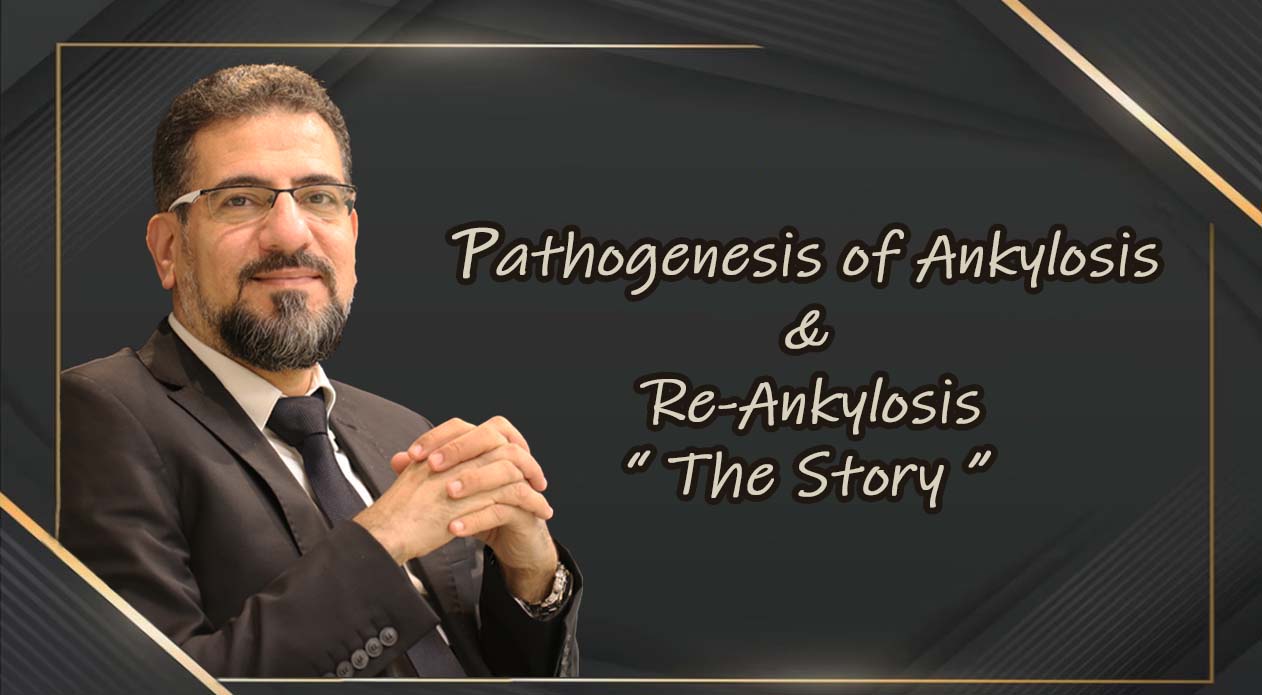Prof. Ayman Hegab is a Professor of Oral & Maxillofacial Surgery, Faculty of Dental Medicine. Al-Azhar University. Cairo. Egypt.
Abbreviations:
TMJ: Temporomandibular Joint; BMP: Bone Morphogenic Proteins; TGF-B: Transforming Growth Factor-B
Editorial
Ankylosis is the Greek for “stiff joint”. The term “ankylosis of
the temporomandibular joint” (TMJ) refers to bony or fibrous
adhesion of the anatomical components of the joint and their ensuing loss of function. A progressive reduction in jaw movement
is the main clinical presentation. TMJ ankylosis not only affects
mouth opening but also the normal growth pattern of the mandible. Outcome of surgery for TMJ ankylosis is unpredictable.
The type of ankylosis and patient age should be evaluated when
planning surgery. Care in the choice of surgical technique and of
interposition material and subsequent meticulous attention to long-term physiotherapy are considered essential to achieve a
satisfactory result. Iatrogenic causes of ankylosis may arise from
cytotoxic medication, repeated TMJ surgery and irradiation. Repeated TMJ surgery emerged as a dilemma largely confined to
Western countries following the introduction of the concept of
internal derangement and disk displacement which acted as the
catalyst for unmitigated surgical intervention in TMJ disorders
during the 1970s and 1980s [1]. While there have been many
publications regarding the condition and its treatment, very little as been written about its pathogenesis. Due to the difficulty
of operation to release the ankylosis and the high incidence in
the recurrence rate, surgical treatment of bony ankylosis is still a
considerable challenge for maxillofacial surgeons. Understanding the story of pathogenesis of the ankylosis and re-ankylosis
might help in improving the outcome of the surgical treatment [2].
Inciting event (Trauma) leads to three main events; 1- disc
displacement with severe injury to the articular surfaces with
formation of intra-articular hematoma rich in osteoprogenitor
cells (peri vascular undifferentiated pluripotential mesenchymal
cells-PUPMC). 2- Change in local tissue environment includes
disturbances involving the microvasculature and changes in oxygen tension, pH (Alkaline) and blood flow. These local changes of
the tissue produce a milieu that supports osteogenesis. 3- Trauma signal lead to local release of osteoinductive cytokines especially bone morphogenic proteins (BMP), members of the transforming growth factor-B (TGF-B) super family, and genes that
synthesize osteoid and chondroid (matrix) are activated. These
lead to differentiation of the PUPMC into osteoblasts or chondroblasts start lay down of new bone. Trauma is thought to disrupt
the normal balance of connective tissue modeling and remodeling, possibly by inducing local release of a wide array of inflammatory mediators that ultimately lead to the induction of osteogenesis. With decrease range of movement and due to lack of
function after complete ankylosis, heterotopic bone is often diffuse and does not always follow anatomic planes of tissue, which
lead to excessive bone formation and formation of the ankylotic
mass [3,4]. Muscular atrophy regularly occurs as a consequence
of immobilization. Strength decreases most dramatically during the first week of immobilization; little further weakening occurs
later on. Long standing ankylosis associated with changes of the
temporalis and master mules varied from slight degeneration of
muscle fibers, to moderate or severe changes of muscle atrophy
and necrosis [5]. Surgical treatment of the ankylosis resulting in
three major proceedings; 1- creation of gap between two raw
bony surfaces in close approximation especially by the action of
the atrophied muscles. 2- Osseous particles and bone dust created during the surgery as a consequence of surgical cutting of
bone in preparation for arthroplasty, are implanted, albeit unintentionally, into surrounding soft tissues. 3- Postoperative hematoma rich in the “Wandering histiocytes” or inductor cells. These
bone matrix particles (Osseous particles and bone dust) contain
osteogenic cytokines (in particular BMPs) and other growth
factors that stimulate PUPMC resident in the surrounding soft
tissues to differentiate into osteoblasts [4]. Simultaneously with
the “Wandering histiocytes” or inductor cells which activate peri
vascular connective tissue cells or “fixed histiocytes” (induced
cells) to differentiate into specialized osteoprogenitor cells or
chondroprogenitor cells. The osteoprogenitor cells and the stimulated BMP create the correct environment for bone formation.
The progenitor cells start to form bone or cartilage that is subsequently mineralized into mature bone. Where bone induction
took place, a pool of responsive cells surrounded by abundant
capillaries and advancing fronts of osteoblasts were also present [3]. Osteogenic cell differentiation has been shown to start
within 16 hours post-operatively and peaks at 32 hours [6]. In
association of the contributing factors of close approximation of
the articular components, and decreased joint mobility resulting
from the action of the atrophied muscles lead to re-ankylosis.
References
(1) Dolwick MF, Dimitroulis G (1996) A re-evaluation of the importance of disc position in temporomandibular disorders. Aust Dent J 41(3): 184-187.
(2) Ayman F Hegab (2015) Outcome of surgical protocol for treatment of temporomandibular joint ankylosis based on the pathogenesis of ankylosis and re-ankylosis. A prospective clinic
(3) Vanden Bossche L, Vanderstraeten G (2005) Heterotopic ossification: a review. J Rehabil Med 37(3): 129-36.
(4) Lounev VY, Ramachandran R, Wosczyna MN, Yamamoto M, Maidment AD, et al. (2009) Identification of progenitor cells that contribute to heterotopic skeletogenesis. J Bone Joint Surg Am 91(3): 652-663.
(5) El-Labban NG, Harris M, Hopper C, Barber P (1990) Degenerative changes in masseter and temporalis muscles in limited mouth opening and TMJ ankylosis. J Oral Pathol Med 19(9): 423-425.
(6) Craven PL, Urist MR (1971) Osteogenesis by radioisotope labelled cell population in implants of bone matrix under the influence of ionizing radiation. Clin Orthop Relat Res 76: 231-243.




 Ask Prof. Hegab
Ask Prof. Hegab +201004401598
+201004401598

